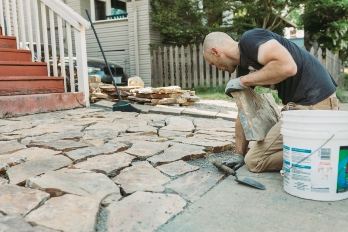For residents along the East and Gulf coasts, hurricane season comes around just as predictably as every other season. It officially runs June through November, peaking August through October. Think Katrina, Sandy, and Harvey. Scary, right? But what have you done to get your home ready for a hurricane?
If your answer is “um … not much,” you’re far from alone. Unfortunately, most of us suffer from disaster denial. That is, we’re strangely bad about taking the risk of natural disasters seriously.
In a Time Magazine poll, half of the people surveyed said they had personally experienced a natural disaster or a public emergency, and yet only 16 percent of those said they were “very well prepared” for the next one. Meanwhile, more than 90 percent of Americans live in places where the risk of a natural disaster is moderate to high.
As for hurricanes specifically, many people don’t realize that the storm surge is the most dangerous part, and that intense winds, rain, and flooding can affect areas hundreds of miles inland.
Ready to get past disaster denial and get ready for hurricane season? Good! Read on for critical tips on how to protect your home. As for your personal safety, you’ll find several downloadable checklists at HurricaneSafety.org.
Be ready for the water
Storm surge is extremely dangerous. If you’re on the coast, know that a big surge can rise to your roofline in a matter of seconds. Be ready to evacuate if officials say to. The best you may be able to do for your home before you get out is close the basement windows and turn off the gas and electricity (be sure you know how).
Prepare for rain and flooding, even inland. Hurricanes can dump massive amounts of rain. In the case of Harvey, as much as 50 inches in parts of Texas. Even areas far from the coast can be devastated. Case in point: In 2011, hurricane Irene hit Vermont so hard that some areas are still recovering. Parts of the state got 11 inches of rain, and rivers swelled from scenic to wild. More than 2,400 roads, 800 buildings, and 300 bridges (including some lovely covered bridges) were destroyed or damaged.
- How close are you to a river?
- Should you consider a sump pump?
- Are your gutters clean, with downspouts directing water well away from your home?
Reinforce your garage door
Because your garage door is big, you might think that it’s strong. More likely, you haven’t thought about it at all. But garage doors are usually pretty flimsy. In high winds, they often blow in or get pushed out by negative pressure. But the real problem is what happens after that.
Once that wind gets inside your garage, the roof can tear off, which in turn can tear off the side of the house if it’s attached. Yikes. According to the Federal Alliance for Safe Homes, around 80 percent of residential hurricane damage starts with wind coming in through garage doors.
Experts say that if there’s only one bar across each of your garage door’s panels, it’s not going to withstand hurricane-force winds. A wind- and impact-resistant double garage door will probably set you back at least $1,500. A more affordable solution is a vertical garage door brace. Here’s a wind-brace kit recommended by Consumer Reports.
If anyone knows hurricanes, it’s Florida’s Division of Emergency Management. Read their garage door protection guide for everything you need to do and NOT do.
It’s not a bad idea to reinforce regular doors too. Three hinges are better than two, and an inch-thick deadbolt helps.
Don’t let your roof sail away
If you live in a high-risk area, your roof might already have metal “hurricane clips,” also referred to as “ties” or “straps,” especially if your home is newer. They strengthen the attachment of the roof to the walls of the house so it doesn’t pull off and sail down the block. If you have easy access to your attic’s rafters, you might even be able to retrofit these for $400 to $600.
Hurricane straps or not, it’s a good idea to regularly inspect your roof (and siding) for loose, cracked, or missing shingles. Anything loose could get torn off during a hurricane, opening the possibility of more tearing and water penetration.
Porch or carport? Think about what happens to an umbrella in high winds … and make sure the posts are (very) firmly anchored to the ground.
Get some real window protection
Tape won’t help and could hurt. Every time there’s a hurricane heading for the coast, we inevitably see news footage of homes with a big X of tape across each picture window. Will it surprise you to learn that even duct tape is no match for 110-mph winds? All tape does is increase the chances that the glass will break into larger, more dangerous shards.
Opening windows won’t help either. Here’s another window myth: slightly opening them will “equalize the pressure” and help prevent damage. The reality is, your home isn’t airtight, so the pressure will equalize without your help. Windows should in fact be closed. Open windows only let in rain and flying debris.
Plain-old plywood to the rescue. Simple 5/8-inch plywood covers offer good protection. With inexpensive “window clips” that go on without screws or nails, a typical home can be boarded up in less than half an hour (assuming the plywood covers are ready to go). Lowe’s sells several types. Check out Lowe’s DIY guide to boarding up windows. Don’t forget glass panes in doors. For a step up from plywood, consider polycarbonate panels.
The ultimate: hurricane shutters. If your home is seriously exposed, consider full-on hurricane shutters, also known as impact shutters. Here’s a sampling of the various types.
Don’t forget the hazards in your yard
If your yard is full of stuff that might go airborne in high winds, here are a few tips to prevent that from happening:
- Trim dead limbs from trees
- Be ready to bring in the grill, lawn chairs, and so on
- Large things like picnic tables that you can’t get inside should be anchored to the ground (or you should be ready to anchor them fast)
- Think about replacing gravel and rock landscaping material with something that’s less hazardous when it’s flying, like bark mulch
Review your homeowners insurance
No disaster preparedness article would be complete without an insurance reminder, so:
- Is your insurance up to date?
- Are you insured for full replacement value?
- Should you consider flood insurance? Storm surge is classified as flood damage, and remember Vermont! There’s often a waiting period before flood insurance takes effect, so check this one off your list sooner rather than later.
- Is your home inventory up to date, so you can document any losses and get paid fast and in full?
Remember too that many insurance companies offer discounts on your premium for improvements that help your home resist hurricanes.
Help fight disaster denial! Please share this post with your friends and neighbors. They just might thank you. And maybe, just maybe, their picnic table won’t take flight and smash your car when the next hurricane comes to town.




